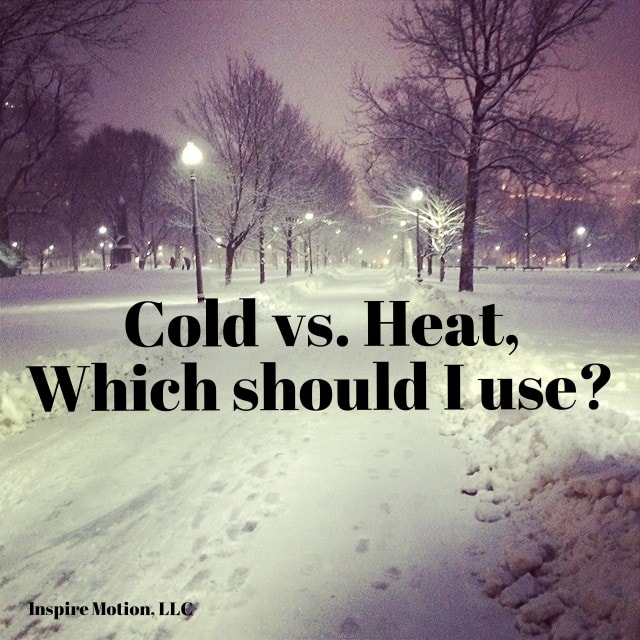Cold versus heat, that is the question. So, this is a very common question that therapists get asked and I hope to clear some things up so that next time you have an ache or injury you’ll know which one to use. So, first before you can even choose ice or heat it’s best to understand acute versus chronic inflammation.
Acute Inflammation
The acute inflammatory process is rather complex, but usually starts with some kind of a trauma, a fall, a cut, blow from an object, or sprain/strain of a joint. Your body responds to the process in a rather complex chemical reaction that could take up a full post on its own. Basically depending on the kind of injury that has occurred, swelling will result because of the transport of white and red blood cells to begin the healing process. Characteristics generally consists of redness, swelling, pain, heat, and possible loss of function. Pain from acute injuries is generally sharp, stabbing, or throbbing in nature. You may even notice bruising near the site of injury or even distal (below) to the injury. So, for example people who injury their knee may notice swelling all the way to their ankle. Patients who are post hip surgery or injury may notice swelling into their knee and ankle. This is perfectly normal, however swelling can cause irritation of these joints, which is why it’s very important to elevate the limb to help with the swelling.
Just remember the acronym RICE:
R– Rest
I– Ice
C– Compression
E– Elevation
Elevation and ice together are key to helping with swelling. Depending on your injury movement is also important due to the action of your muscles help with assisting the lymph system to function in removing waste and excess fluid after injury. Now depending on the type of injury you sustain, the acute phase of the inflammatory process generally lasts about 2 weeks. So, it’s key to use ice within the first few weeks after an injury and avoid heat until your injury is more stable. However, if swelling continues to be present for greater than 2 weeks, which commonly happens, it’s appropriate to continue using ice.
The reason that ice is important to use after an acute injury is that it causes your blood vessels to constrict and reduce blood flow (vasoconstriction) to that area to slow down the swelling process. Now, don’t worry that icing will suddenly prevent blood from getting to the area, you want vasoconstriction, and it doesn’t last very long. Vasoconstriction will only last for about 15-20 minutes of using ice, because after this time your body will then begin vasodilation which is an increase in blood flow. It’s your body’s way of trying to warm up the area again and prevent tissue damage from the cold. You may even notice this affect when performing cardio in cold weather; you start out cold, and before you know it you’re removing layers to stay cooler.
Chronic Inflammation
So, chronic inflammation is rather complex and there are varying degrees of this kind of inflammation. Generally chronic inflammation can occur after acute inflammation, and usually is due to a disruption in the normal healing process causing inflammation to continue to cause damage to the tissues. You’ll usually be diagnosed with chronic inflammation if the pain has lasted for months or even years. Examples of this kind of inflammation can be related to say a torn meniscus, rotator cuff, or tendonitis. This is also why it’s important to allow for some rest after an acute injury. Some people will return to certain activities sooner than they should which can result in the prolonged inflammation. Overuse syndromes typically related to repetitive activities also create inflammation, such as prolonged typing, repetitive lifting and throwing… such as tennis elbow. Chronic inflammation is challenging to treat and honestly requires skilled intervention to help manage and reduce due to the complex array of conditions.
Now, you can also develop chronic inflammation from an auto immune disorder, such as rheumatoid arthritis. Chronic inflammation can cause scaring and deformity which you’ll see in folks with rheumatoid arthritis from their marked joint disfigurement over time.
Generally with chronic inflammation most people can use either ice or heat. I’ve found that with chronic inflammation most people have a preference between hot or cold. Some people who suffer from chronic inflammation, such as fibromyalgia, prefer heat because they tend to be sensitive to cold. Chronic inflammation may also require more aggressive interventions that we won’t discuss at this time because right now let’s keep things simple, more on other treatments another time.
Application
When to Use Ice, and How….
Now that you have a little background on the difference between acute and chronic inflammation, you can now understand that generally ice is a user friendly treatment, and can be used for both chronic and acute injuries. So, here are some tips on how to use ice.
10 minutes On, 10 minutes Off X 2 repetitions
Use an ice pack inside of a pillow case and place over the area of injury and do your best to elevate the area above your heart and set a timer for 10 minutes. So, you’ll keep the ice on for 10 minutes, then take it off for 10 minutes, then repeat with fresh ice for another 10 minutes. 10 minutes is the best timing to get the vasoconstriction results you want for reducing the affects of swelling.
Ice Massage
Now this is a great technique for inflammation that is localized to a small area, such as tendonitis of the elbow or knee; it also only takes 5 minutes. Fill a dixie cup with water and freeze. Once frozen remove it and tear the upper portion off to expose the ice but still have an area covered to hold without freezing your fingers. Place the ice directly to the skin and move in a circular area around the inflamed location. Do this for about 5 minutes. The area will first burn a bit and then go numb. DO NOT go longer than 5 minutes. Do not give yourself frost bite!
When to Use Heat, and How…
Heat is generally user friendly, but timing is important. You DO NOT want to use heat with acute inflammation or injury. Think about how awful a hot or warm shower feels after a sunburn, not friendly for acute injuries. Heat helps bring more blood to an area, so when you’re trying to reduce swelling, which is generally related to acute inflammation, you want to avoid too much vasodilation.
Dry Heat
You can purchase or make your own rice/bean sacks to heat up in the microwave such as this super easy home-made rice pack. You can also get an electric heating pad to place over the area. Place on the area of pain or tension. Only apply for about 15-20 minutes, and keep in mind how hot it feels, if you can’t tolerate it, it’s too hot. Please always follow the directions of whatever product you purchase and utilize.
Moist Heat
There are several moist heat products out there on the market. There are heating pads with a moist sponge included that you just get damp and use with the pad. People with hand or foot pain can now purchase paraffin wax machines for home and do their own “spa” treatment. When using paraffin be sure to wash your hands or feet before using the wax to keep it clean and prolong the use of the wax. You’ll dip one hand or foot at a time letting the wax dry just a second then dip again, dry and repeat. You can repeat as many times as you want depending on how thick you want the wax. You’ll then try to quickly place your hands or feet into a plastic sleeve and then warm hand or foot mitts; these usually come with the home-kit. It’s recommended to use for about 10-15 minutes or till not warm, and again keep in mind how you tolerate the heat and avoid burning your tissues, don’t keep your hands in the wax for longer than a few seconds.
WARNING: Please be safe about the products you choose to use, and follow the directions to avoid injury. I have had patients who have used heating pads so frequently for too long at high temps that they’ve burned themselves, or permanently bruised their superficial tissues.
Please feel free to share any products that you may have found to be useful as well!
Written by: Natasha Heitman, DPT


